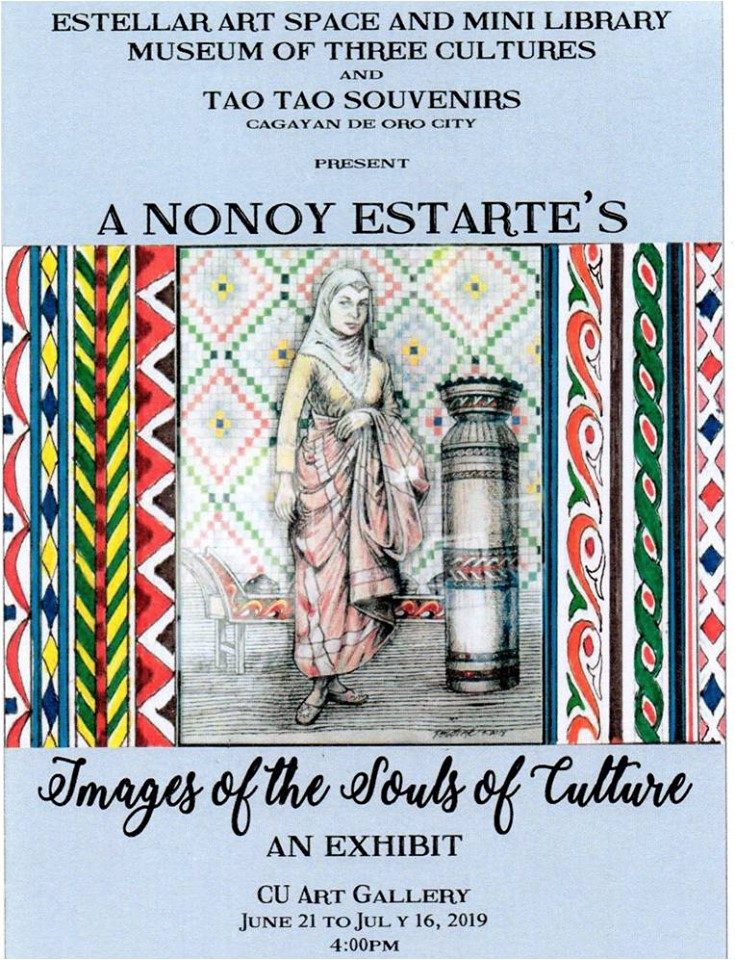SUMMARY
This is AI generated summarization, which may have errors. For context, always refer to the full article.

Perhaps no other artist has exerted so great an influence on the development and growth of visual arts in Cagayan de Oro as Pennessencio “Nonoy” Estarte, a self-taught painter, illustrator, muralist, and cartoonist, originally from Malangas, Zamboanga Sibugay.
He died on Monday, May 22, at the age of 72.
During his formative years, Estarte was greatly influenced by a grade school teacher and was further exposed to art by an American Peace Corps volunteer artist.
In 1978, the late Father Francisco Demetrio, SJ, founder of Museo de Oro (formerly Xavier Folklife Museum) took Estarte under his wing as their resident artist. Later, he became assistant curator of files and records, and eventually assistant museum curator. Demetrio frequently sent him to conferences, workshops, and lectures on museum development projects, art, and other educational programs.

During his long years of service in the museum, Estarte also immersed himself with the indigenous peoples of Mindanao, including the Talaandig and Manobo.
“I was able to visit the far mountains in San Fernando, Lantapan, Bukidnon, and Lapuyan, Zamboanga del Sur,” he had shared. “What did I do there? I witnessed various rituals, weddings, datuship rituals and peace rituals. I came to know better these ethno-linguistic groups like Manobo, Higaonon, Talaandig, Matigsalog, Maranao(sic), Maguindanao, and Subanon. It was a great immersion in culture.”
“Some of the personalities in my exhibit I came to know personally: the late Datu Kinulintang, Supreme Datu of the Talaandig; Datu Vic Saway, his son; Nanay Igbi, a Subanon Bae and musician,” he had added.
Estarte had been part of several local group exhibitions and had held solo exhibits at Xavier University.
During the June 2019 launch of his exhibit Images of the Soul of Culture, held at the Capitol University Museum of 3 Cultures, the artist said the exhibit was a collection of illustrations done during his long years of service to Museo de Oro, reflecting his passion for folklore, history, and indigenous communities.

“The exhibit is not intended for argument or strict critical discourse, but is an art form from the heart to the heart. I always love to see simple people, street kids, Lumads that appreciate my art. I want to see young students understand and value my art. I wish my art becomes an instrument for formation and transformation.”
His Manobo epic paintings were also selected as part of the Philippine Summer Festival in Munich, Germany in 1986, and were later exhibited at the Delf Museum in the Netherlands in 1987.
Estarte was instrumental in the creation of programs for artists in Cagayan de Oro, foremost of which was the Oro Art Guild (now Cagayan de Oro Art Guild). He also helped organize the Xavier University Circulo de Arte for students.
“Art is the only platform I know, where my ideas, vision, creativity, and dreams are substantially expressed,” the artist had said. “For 30 years in XU (Xavier University) I had a great opportunity to work, interact with great people, like the late Fr. Francisco Demetrio, Dr. Erlinda Burton and John Burton, Tony and Joy Enriquez, and Lovenia Naces, and many others.”
Editor’s Note: An earlier version of this story reported that it was Lovenia Naces who approached Nonoy Estarte about the social enterprise idea. This has been corrected.
Lovella Naces-Eduave, the daughter of Lovenia Naces, had approached Estarte with the idea of a social enterprise that would teach the world about the Philippine indigenous communities through souvenirs. “Sir Nonoy was happy because he also shared the same advocacy of promoting and preserving IP culture,” Lovella said.

Together with the Department of Education’s Ghela Simon, the three co-founded TaoTao Souvenirs. Lovella noted how Estarte’s experience in the museum was key to designing the tools used by the community for the production of the souvenirs.
“Nonoy has helped the archdiocese with some of his paintings – of the Birhen sa Kota history, the mysteries of the rosary, portraits of the Blessed Virgin Mary, and most of all, the grand mural of the story of the diocese with its first four archbishops. This painting is hung at the front lobby of the Bishop’s House,” said Monsignor Antonio Ledesma, SJ, Archbishop Emeritus of the Roman Catholic Archdiocese of Cagayan de Oro.
Ledesma also described how Estarte visually depicted the folklore narratives of Mindanao.

“Some of his whole-screen paintings are exhibited in the XU Museo de Oro such as the Birhen sa Kota in front of the early Spanish fortress; the first settlement organized by the Recoleto missionaries in Cagayan; the layout of the early city; the peace treaty in Tigkalaan among the lumad communities; etc.,” Ledesma said.
He added: “He also creatively illustrated some of the folklore accounts of the Indigenous People, such as the multi-story heaven for righteous souls, the aswangs, etc. In all, Estarte was a prolific visual artist who brought to life the many folklore anecdotes gathered by Fr. Demetrio and his students throughout Northern Mindanao.”
After serving the XU Museo de Oro for 30 years, Estarte retired as assistant curator in 2013 due to his failing health. He then established the Estellar Art Space and Mini Library for artistically inclined youths at Xavier Heights in Uptown Cagayan de Oro. – Rappler.com
Add a comment
How does this make you feel?








There are no comments yet. Add your comment to start the conversation.